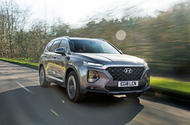
Hyundai’s US-market breakthrough SUV aims for greater European success
The Hyundai Santa Fe might seem to European eyes like something of a bit-part player in the SUV market, but it has a celebrated status within the car maker’s own internal company circles.This car’s introduction was a watershed moment in the development of Hyundai’s fortunes in the all-important North American car market. When the first-generation version was introduced in 2000, the Korean firm sold just shy of a quarter of a million cars in the US; but, by the time it was replaced, Hyundai’s US sales footprint had almost doubled. Buyers on the other side of the pond instantly warmed to the value, practicality, comfort and convenience of this car in a way that made its reception elsewhere in the world of much less import.So how do you update and change the Santa Fe in order to cash in on the global appetite for cars of its ilk without putting such established success at risk? It’s a question that must have been pondered more during the design and engineering process of this fourth-generation version than on either occasion when the Santa Fe has been replaced before. There are so many enlarged, seven-seat-adapted compact European SUVs encroaching on its patch, as well as a burgeoning set of premium-branded compact and mid-sized SUVs – therefore many more ways to spend a Santa Fe-sized budget on a family 4×4 than there was even five years ago.Hyundai’s answer, which the Autocar road test microscope is focused on this week, broadly seems to be ‘steady as she goes’. The fourth-generation Santa Fe gets smarter looks, a stiffer, lighter chassis, and new suspension and driveline systems. And, though we’re testing it with the familiar 2.2-litre four-cylinder diesel engine, it will also be the first car of its lineage to depart from diesel power, with Hyundai preparing to introduce petrol-electric hybrid and plug-in hybrid versions in the medium-term future.Hyundai Santa Fe design & stylingThe Santa Fe’s UK market success has, to a significant degree, been built on metal-for-the-money value. And so, while it was already one of the bigger SUVs on which you could spend £30,000-plus, the fact that it’s just got a little bit bigger probably won’t hurt its sales potential.At 4770mm in length, the car is now within a few inches of a BMW X5, and splits the difference between a Land Rover Discovery and Discovery Sport on occupied kerbside real estate almost exactly. And yet, as you might imagine, the Santa Fe is a long way from splitting the difference between those two Land Rovers so precisely on price. More on that in due course.The car’s underbody construction remains an all-steel monocoque, although it has a greater proportion of hot-stamped, high-strength steel in it than any other Hyundai. The body is suspended independently, via struts up front and multiple links at the rear, above which you’ll find steel coil springs and a damping system that offers a self-levelling function for all UK-market specifications.Four-wheel drive isn’t likewise standard on all versions; and, what’s more, this is the first time that Hyundai UK has offered a front-driven Santa Fe – although not the first time that the car has been without rear driveshafts in a global sense. There is, for now, only one engine on offer: a redesigned version of Hyundai’s ‘R’-family 2199cc CRDi turbodiesel four-cylinder motor, which mounts transversely under the bonnet and produces 197bhp and 325lb ft.In both cases, that’s precisely what the outgoing Santa Fe had – although Hyundai’s engineers may well have considered it a good result to reproduce those outputs on an engine that’s needed revised combustion control, reduced internal friction, a particulate trap, a selective catalytic reduction system and a lean NOx trap to satisfy current Euro 6d-TEMP emissions requirements.Buyers can opt for a six-speed manual or eight-speed automatic gearbox regardless of their choice on number of driven wheels – and if they do go for four-wheel drive, as was fitted to our top-of-the-range automatic test car, they’ll get Hyundai’s latest HTRAC four-wheel-drive system, which allows you to vary the default torque split from 50:50 front-to-rear (for loose surfaces and more balanced handling) through to entirely front-drive (for optimal fuel economy).Even with four-wheel drive, however, the Santa Fe shouldn’t be mistaken for the most capable, dual-purpose utility car of its size. Ground clearance is pegged at a pretty average 185mm; several of the car’s off-road clearance angles are below 20deg; and, even though manual versions of the car are rated to tow more than autos, none will manage over 2.5 tonnes on a braked trailer.Price £43,295 Power 197bhp Torque 325lb ft 0-60mph 9.3sec 30-70mph in fourth 9.8sec Fuel economy 37.5mpg CO2 emissions 164g/km 70-0mph 46.8m (damp)
Source: Autocar